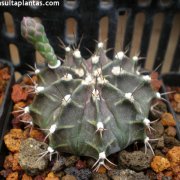Care of the cactus Gymnocalycium damsii o Gymnocalycium anisitsii |
|
The genus Gymnocalycium, family Cactaceae, includes more than 60 species of cacti native to South America. Some species are: Gymnocalycium damsii, Gymnocalycium saglionis, Gymnocalycium baldianum, Gymnocalycium mostii, Gymnocalycium denudatum, Gymnocalycium schickendantzii, Gymnocalycium mihanovichii, Gymnocalycium schroederianum, Gymnocalycium andreae, Gymnocalycium pflanzii, Gymnocalycium vatteri, Gymnocalycium platense, Gymnocalycium gibbosum. Scientific synonym: Gymnocalycium anisitsii. This species is native to Bolivia, Paraguay and Brazil. They are cacti with a spherical body, slightly flattened at the apex, pale green or brownish green with clear horizontal lines that reach 10 cm (3.93") in height; produce lateral suckers. They have up to 10 sharp ribs with bumps. They have 5-8 short straight or slightly curved radial spines. The flowers appear at the apex of the plant, are funnel-shaped and white or pink. They can bloom throughout the year. Gymnocalycium anisitsii is used in rockeries and in pots as greenhouse plants, indoor plants and on balconies, terraces and windows. Gymnocalycium damsii prefers semi-shade exposure, avoiding direct sunlight in the middle of the day. It appreciates several hours of direct sun in the early morning or late afternoon. It resists occasional frosts down to -5 ºC (23 ºF) if the substrate is dry. The soil can be a commercial cacti substrate with 15% coarse sand. Gymnocalycium anisitsii does not tolerate calcareous soils. Transplanting is done in early spring. Always water moderately, waiting for the substrate to dry completely. Do not water in winter. Fertilize once a month in summer with mineral fertilizer for cacti. Gymnocalycium damsii does not need pruning. Gymnocalycium anisitsii can be attacked by fungi if there is excess watering and by red spiders and mealybugs if the ventilation is not adequate. Gymnocalycium damsii is propagated by sucker separation and from seeds sown in late winter. |
Images of the cactus Gymnocalycium damsii o Gymnocalycium anisitsii |
Find plants
Gymnocalycium damsii o Gymnocalycium anisitsii | Care and Growing
© 2026 FavThemes
